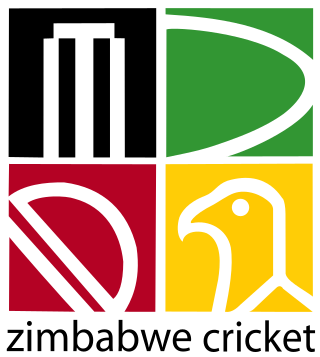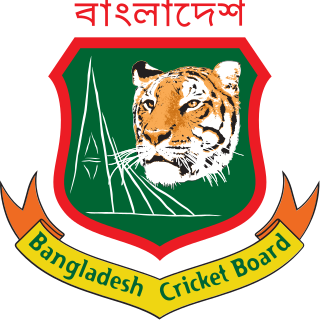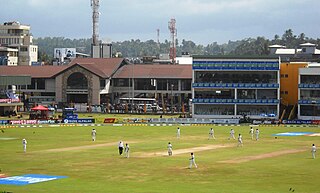Related Research Articles

The Zimbabwe men's national cricket team, also known as the Chevrons, represents Zimbabwe in men's international cricket and is overseen by Zimbabwe Cricket. Zimbabwe has been a Full Member of the International Cricket Council (ICC) since 1992. As of May, 2023, Zimbabwe was ranked 10th in Tests, 11th in One Day Internationals (ODIs) and 11th in Twenty20 internationals (T20Is) by the ICC.

The Bangladesh men's national cricket team, popularly known as The Tigers, is administered by the Bangladesh Cricket Board (BCB). It is a Full Member of the International Cricket Council (ICC) with Test, One-Day International (ODI) and Twenty20 International (T20I) status.

Kumar Chokshanada Sangakkara is a Sri Lankan former professional cricketer who represented Sri Lanka from 2000 to 2015. A former captain in all formats. He was born in Matale, Central Province. In first-class cricket, he played for Nondescripts Cricket Club from 1997–98 to 2013–14 and for Surrey County Cricket Club from 2015 to 2017. Sangakkara is widely regarded as one of the greatest cricketers of all time. He was a key part of the Sri Lankan squads which won the 2001-02 Asian Test Championship, 2002 ICC Champions Trophy and 2014 T20 World Cup.
Mohamed Farveez Maharoof, or Farveez Maharoof, is a Sri Lankan former professional cricketer, who played Tests and ODIs. He first made his impression in the 2004 Under-19 Cricket World Cup in which he captained the Sri Lankan team. He enjoyed a prolific school career for Wesley College, with a highest score of 243 and best bowling figures of 8 for 20. An all-rounder, he made his Test debut in 2004. He was part of the Sri Lankan team which finished as runners-up at the 2007 Cricket World Cup.

The Kenya men's national cricket team represents the Republic of Kenya in international cricket. Kenya is an associate member of the International Cricket Council (ICC) which has Twenty20 International (T20I) status after the ICC granted T20I status to all its members.

Galle International Stadium is a cricket stadium in Galle, Sri Lanka, situated near Galle Fort and fringed on two sides by the Indian Ocean. It is considered to be one of the most picturesque cricket grounds in the world. Before being brought up to international cricket standards, it was known as 'The Esplanade', and is the home ground of the Galle Cricket Club. This Stadium is identified as one of the luckiest venues for the Sri Lankan national cricket team.

Gaddafi Stadium, previously known as Lahore Stadium, is a cricket stadium in Lahore, Punjab, Pakistan, owned by the Pakistan Cricket Board (PCB). With a capacity of 27,000, it is the fourth largest cricket stadium of Pakistan. It is the home ground of Lahore Qalandars in the Pakistan Super League. Gaddafi Stadium was the first cricket stadium in Pakistan to be equipped with modern floodlights with their own standby power generators. The headquarters of the Pakistan Cricket Board are situated at Gaddafi Stadium, thus making it the home of the Pakistan national cricket team.

The England Lions cricket team is England and Wales' "second-tier" team, below the full England cricket team. It is largely intended as a way for promising young cricketers to gain experience of playing international cricket.

The Bangladesh A cricket team, also known as Bangladesh Emerging cricket team, is a cricket team representing Bangladesh, and is the second tier of international Bangladeshi cricket below the full Bangladesh national cricket team. The team played its first game, against the full Pakistan side, at Bangladesh Krira Shikkha Protisthan Cricket Ground in 5 January 2002.
Alexander Graeme Cremer is a former Zimbabwean cricketer who captained the national cricket team between May 2016 and March 2018. He is a leg-spinner who got into the Zimbabwe side at the age of eighteen, following the exit of Paul Strang, Andy Whittall and Ray Price.
Sean Colin Williams is a Zimbabwean international cricketer who is a former captain of the national team in Test cricket. He plays Tests and One Day Internationals, and formerly T20Is, primarily as a batting all-rounder. In September 2019, Zimbabwe Cricket named him as Zimbabwe's captain, after Hamilton Masakadza retired from international cricket. Later the same month, Williams captained Zimbabwe for the first time, in the opening Twenty20 International (T20I) match of the 2019–20 Singapore Tri-Nation Series, against Nepal.

The National Stadium, now known as National Bank Stadium for sponsorship reasons, is a cricket stadium in Karachi, Sindh, Pakistan, owned by the Pakistan Cricket Board. It is the home ground of the Karachi Kings franchise in Pakistan Super League and of many other domestic cricket teams in Sindh. It is the largest cricket stadium in Pakistan with a capacity to accommodate 34,000 spectators. It was built in the early 1950s under the supervision of senior civil engineer Mr. Abdul Rasheed Khan (WP) and Mr. Kafiluddin (EP), and was formally inaugurated in April 1955. In October 2022, the National Bank of Pakistan and the PCB agreed to a five-year naming-rights agreement, and the Stadium got its new title, National Bank Cricket Arena.
The history of cricket in Zimbabwe, formerly Rhodesia and before 1965 Southern Rhodesia, includes Rhodesia first forming a first-class cricket team in August 1890, and the inaugural Test appearance of Zimbabwe in October 1992.
The history of cricket in Bangladesh predates the foundation of the Bangladeshi state in 1971 by nearly two centuries. Cricket was introduced to Bengal by the British in the eighteenth century but its growth in East Bengal was slow. Following Partition and the creation of East Pakistan, both first-class and Test cricket were played there during the 1950s and 1960s. Although cricket continued to be popular after independence, especially in Dhaka, the country lost first-class status and had to establish itself in international competition as an Associate Member of the International Cricket Council (ICC).
Cricket was introduced to Sri Lanka in the first quarter of the 19th century, following colonisation of the island by the British. The earliest known match was recorded in 1832 and the earliest first-class one in 1926. The national team has played Test cricket from 1982. The national team has achieved international success by winning the 1996 Cricket World Cup and the 2014 ICC World Twenty20. Cricket is played nationwide with Test venues in Colombo, Galle, Kandy and Moratuwa. The country's most notable players include Aravinda de Silva, Arjuna Ranatunga, Rangana Herath, Sanath Jayasuriya, Mahela Jayawardene, Muttiah Muralitharan, Kumar Sangakkara and Chaminda Vaas. Administration and governance are performed by Sri Lanka Cricket, which was founded in July 1922 as the Ceylon Cricket Association (CCA). The main domestic competition is the Premier Trophy which attained first-class status in 1988.
International cricket teams raised by Marylebone Cricket Club (MCC) have visited Sri Lanka, formerly Ceylon, on 23 occasions from 1911-12 until the most recent tour in the winter of 2000-01. Eleven of the teams were England national cricket teams raised by MCC during the period when it held responsibility for Test cricket played by England. The other twelve were MCC teams per se which did not take part in Test cricket.
In the history of Australian cricket from the 1970–71 season until 1985, notable Australian players include brothers Ian and Greg Chappell, Jeff Thomson, Dennis Lillee, Rod Marsh and Doug Walters.
The Pakistan cricket team toured Sri Lanka from June to August 2009. The team played three Test matches, five One Day Internationals, and one Twenty20 International against Sri Lanka. The tour was the return tour of the Sri Lankan cricket team in Pakistan in 2008–09, where during the second test the match was abandoned due to a terrorist attack on the Sri Lankan cricket team which injured seven players, three staff and killed six Pakistani policemen and two civilians.
The Sri Lankan national cricket team toured Zimbabwe in October 1982 and played two first-class matches against the Zimbabwean national cricket team before Zimbabwe was elevated to Test status. In addition, the teams played a two-match series of Limited Overs Internationals (LOI). Sri Lanka were captained by Duleep Mendis and Zimbabwe by John Traicos.
The Indian national cricket team toured Sri Lanka in January and February 1974 to play two first-class and two limited overs matches against the Sri Lankan national cricket team. There were two further first-class matches against the Sri Lanka Board President's XI. India defeated Sri Lanka at the Sinhalese Sports Club Ground by 6 wickets but the other three first-class games were impacted by the weather and were drawn. As Sri Lanka had not then achieved Test status, the internationals are classified as first-class matches. The Indian team was captained by Ajit Wadekar and Sri Lanka by Anura Tennekoon.
References
- ↑ "Zimbabwe in Sri Lanka, 1983". CricketArchive. Retrieved 12 June 2014.